Oasi Architects’ FGN House is an exercise in concrete subtlety

The sleepy village of Fagnano Olona in Italy – also home to an Aldo Rossi-designed elementary school – has just welcomed a new piece of modern architecture; a new-build house by Busto Arsizio-based architects Oasi. The structure, a home for a local family, is a clear departure from the area's more conventional housing and an exercise in subtle concrete architecture.
Named FGN House, the building is composed of three simple volumes which interlock in different ways, creating a variety of spaces, both inside and out. The structure sits on the grounds of an old fruit orchard. Its layout is simple; a generous main ground level houses the open plan living, dining and kitchen areas. Three family bedrooms are also placed on this floor. A carefully crafted concrete and timber staircase leads up to a rooftop pavilion that contains a study. This pavilion elegantly punches through the accessible roof terrace which provides extra outside space for the family and offers views across the surrounding roofscape.

The structure, named FGN House, is the home of a young local family.
The ground level remains in constant dialogue with the outdoors, through large openings that look out towards the garden and the different courtyards formed by the concrete formations – there's a main entrance patio and a further two terraces in different parts of the house.
The architects worked with concrete as their main material of choice, adding wooden details where needed, creating a sense of clean, sharp minimalism and gentle refinement. In fact, the material was a key driver for the whole architectural design solution.
‘The main challenge was to respect the relatively low budget, without holding back in terms of creativity, smartness and innovative solutions, as far as generosity of space and the overall architecture were concerned’, explains Oasis co-founder Pietro Ferrario. ‘The project was initially orientated towards a wooden construction but that turned out too expensive, so we looked at other possible solutions with lower costs. In the end concrete was the best and right option. The structure is powered by the material and its shape supports an organised and coherent subdivision of the interiors. At the same time, it generates a relationship between solids and voids that creates attractive living spaces, both inside and out.’
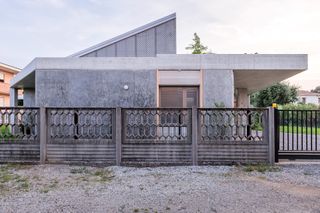
The family bought the plot, which used to be a fruit orchard, to transform it into their primary residence.
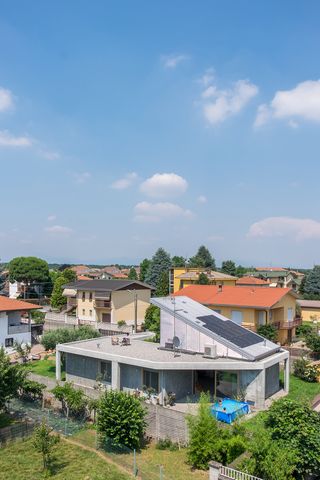
The fairly modest design is composed of three interlocking volumes, explain the architects.
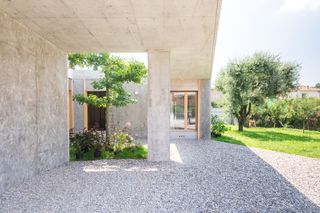
The interaction between these volumes creates open and closed spaces that define the house’s different areas.
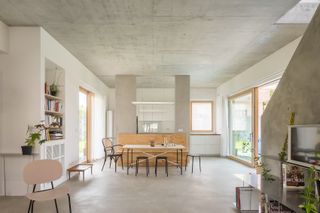
The structure features a big, open plan living and kitchen room with views out to the garden.

A carefully crafted concrete and timber staircase leads up to the first floor, where a study is located.

The main circulation core punches through the ceiling and reaches up to an accessible roof pavilion and terrace.
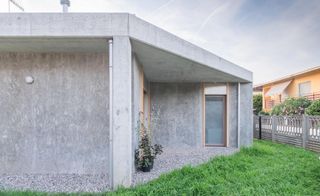
Concrete was the architects’ main material of choice.
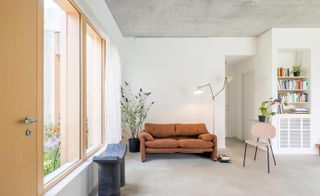
The interiors are in constant dialogue with the outdoors through large windows, an entrance patio and two extra courtyards.
INFORMATION
For more information visit the website of Oasi Architects
Wallpaper* Newsletter
Receive our daily digest of inspiration, escapism and design stories from around the world direct to your inbox
Ellie Stathaki is the Architecture & Environment Director at Wallpaper*. She trained as an architect at the Aristotle University of Thessaloniki in Greece and studied architectural history at the Bartlett in London. Now an established journalist, she has been a member of the Wallpaper* team since 2006, visiting buildings across the globe and interviewing leading architects such as Tadao Ando and Rem Koolhaas. Ellie has also taken part in judging panels, moderated events, curated shows and contributed in books, such as The Contemporary House (Thames & Hudson, 2018), Glenn Sestig Architecture Diary (2020) and House London (2022).
-
 Junya Ishigami designs at Maniera Gallery are as ethereal as his architecture
Junya Ishigami designs at Maniera Gallery are as ethereal as his architectureJunya Ishigami presents new furniture at Maniera Gallery in Belgium (until 31 August 2024), following the series' launch during Milan Design Week
By Ellie Stathaki Published
-
 Reciprocal House offers an unusual case of a London extension
Reciprocal House offers an unusual case of a London extensionReciprocal House by Gianni Botsford replaces a north London Victorian structure, preserving its early Norman Foster extension and bringing the whole to the 21st century
By Ellie Stathaki Published
-
 Utilitarian men’s fashion that will elevate your everyday
Utilitarian men’s fashion that will elevate your everydayFrom Prada to Margaret Howell, utilitarian and workwear-inspired men’s fashion gets an upgrade for S/S 2024
By Jack Moss Published
-
 Giovanni Michelucci’s dramatic concrete church in the Italian Dolomites
Giovanni Michelucci’s dramatic concrete church in the Italian DolomitesGiovanni Michelucci’s concrete Church of Santa Maria Immacolata in the Italian Dolomites is a reverently uplifting memorial to the victims of a local disaster
By Jonathan Glancey Published
-
 Milan’s 10 Corso Como revamp nods to the concept store’s industrial character
Milan’s 10 Corso Como revamp nods to the concept store’s industrial characterMilanese concept store 10 Corso Como unveils its new look by 2050+, a stripped-back design that nods to its 20th-century character
By Ellie Stathaki Published
-
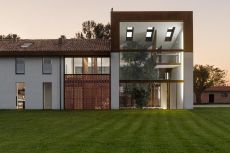 Carlo Ratti announced curator of Venice Architecture Biennale 2025
Carlo Ratti announced curator of Venice Architecture Biennale 2025Carlo Ratti has been revealed as the Director of the Architecture Department at the Venice Architecture Biennale 2025, with the specific task of curating the 19th International Architecture Exhibition
By Ellie Stathaki Published
-
 Floating infinity pool by Herzog & De Meuron at Lake Como is largest of its kind
Floating infinity pool by Herzog & De Meuron at Lake Como is largest of its kindHerzog & de Meuron creates the largest floating infinity pool in the world for Mandarin Oriental in Lake Como
By Lauren Ho Published
-
 The finest brutalist architecture in London and beyond
The finest brutalist architecture in London and beyondFor some of the world's finest brutalist architecture in London and beyond, scroll below. Can’t get enough of brutalism? Neither can we.
By Jonathan Bell Published
-
 Best of brutalist Italian architecture chronicled in new book
Best of brutalist Italian architecture chronicled in new bookBrutalist Italian architecture enthusiasts and concrete completists will be spoilt for choice by Roberto Conte and Stefano Perego’s pictorial tour
By Jonathan Bell Published
-
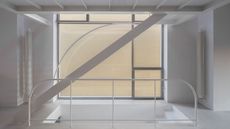 Studio Tropicana, Switzerland and Italy: Wallpaper* Architects’ Directory 2023
Studio Tropicana, Switzerland and Italy: Wallpaper* Architects’ Directory 2023Based in Switzerland and Italy, Studio Tropicana is part of the Wallpaper* Architects’ Directory 2023, our annual round-up of exciting emerging architecture studios
By Ellie Stathaki Published
-
 WeWork Meravigli blends past and present in a 21st-century office space
WeWork Meravigli blends past and present in a 21st-century office spaceWeWork Meravigli launches in Milan, bringing its ornate, historical new home to the 21st century
By Ellie Stathaki Published